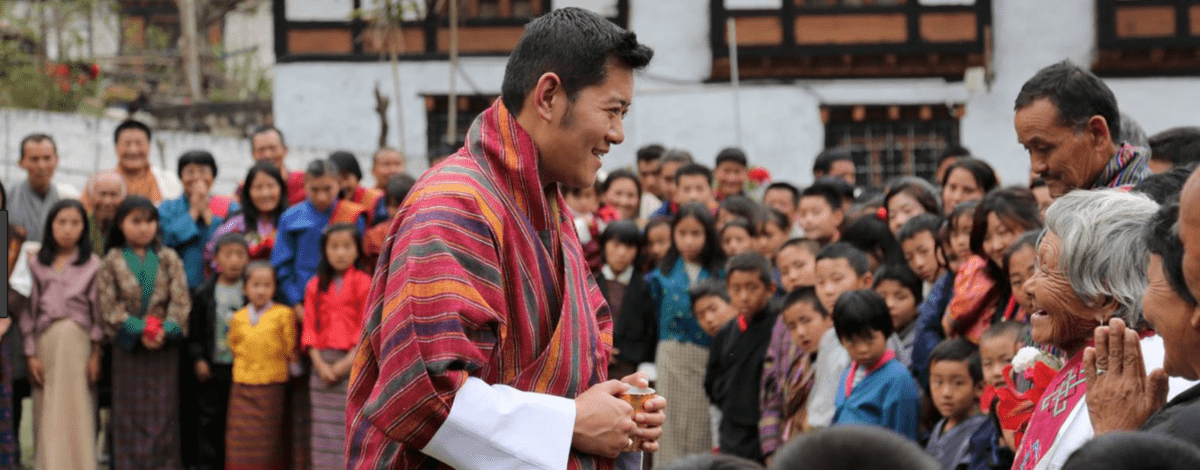By Tshering Yangdon. The government of Bhutan is a democratic, constitutional monarchy with five branches of government, overseeing a population of approximately 800,000 people.
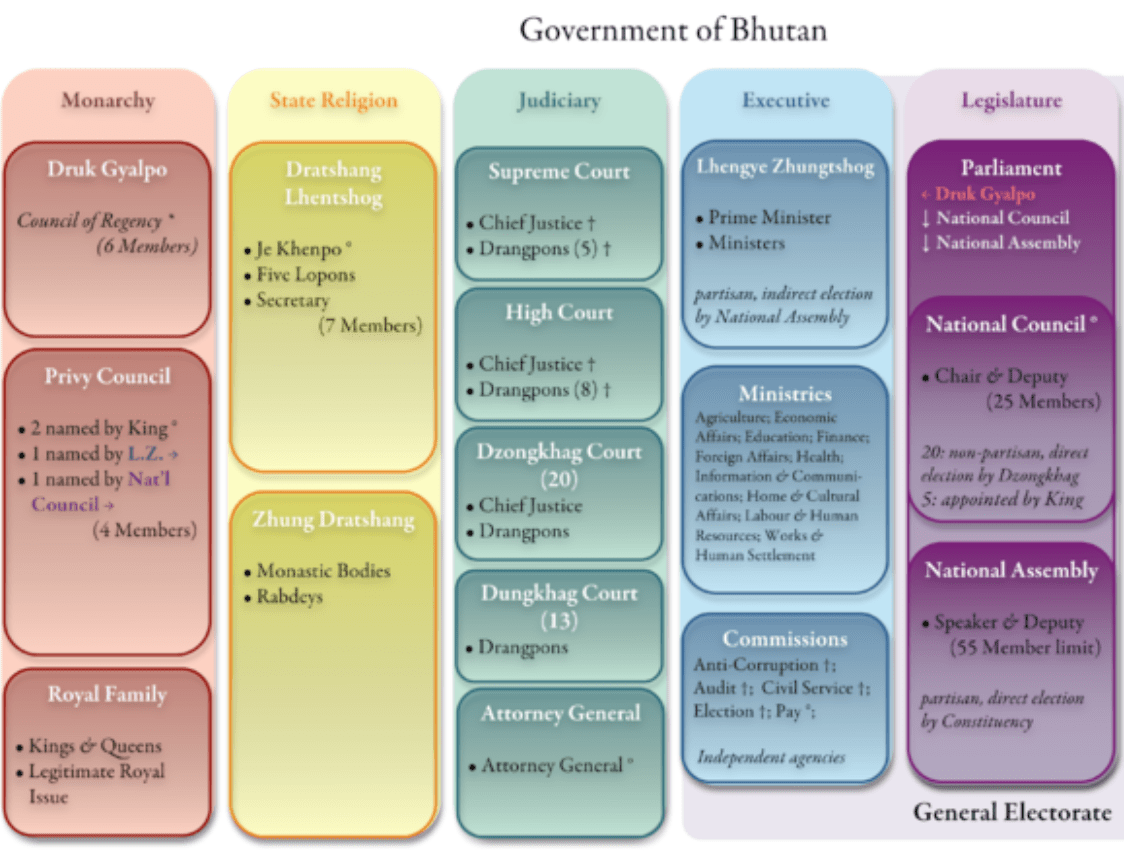
The 2008 Constitution of Bhutan provides for five main branches of government: 1) Monarchy, 2) State Religion, 3) Judiciary, 4) Executive, and 5) Legislative branches. All the secular and religious branches of government are unified under the King. In this constitutional monarchy the King acts as a non-party political head of the government.
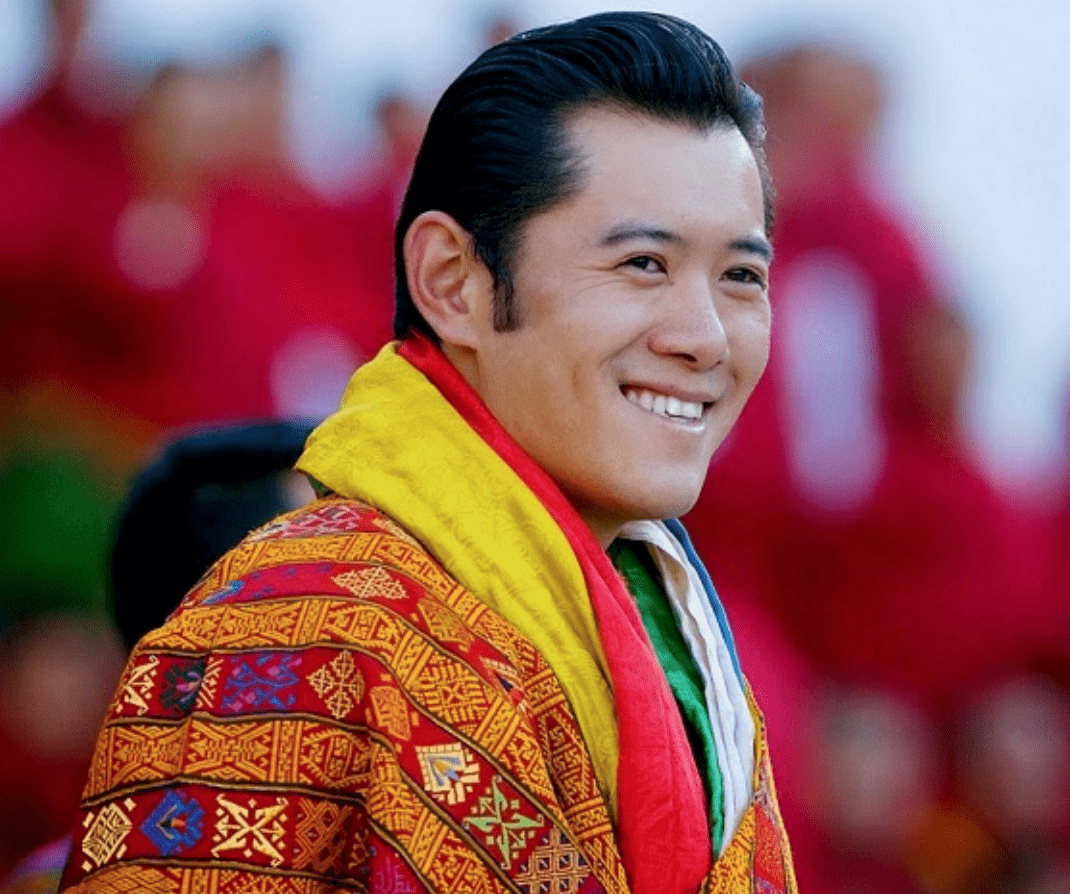
Bhutan’s fifth King, Jigme Khesar Namgyal Wangchuck, is the hereditary head of state. The King of Bhutan is called “Druk Gyalpo”, meaning “King of the Dragon Kingdom”.
1) The Constitutional Role of King
The King plays an important linking role in all areas of democratic government. The King’s day-to-day duties include meetings with the Prime Minister, and other ministers. The King is Commander-in-Chief of the country’s armed forces. The King also travels to different parts of the country to meet his people. The King and Queen make state visits to other countries. Essentially, the king is also responsible for the well-being and happiness of the people.
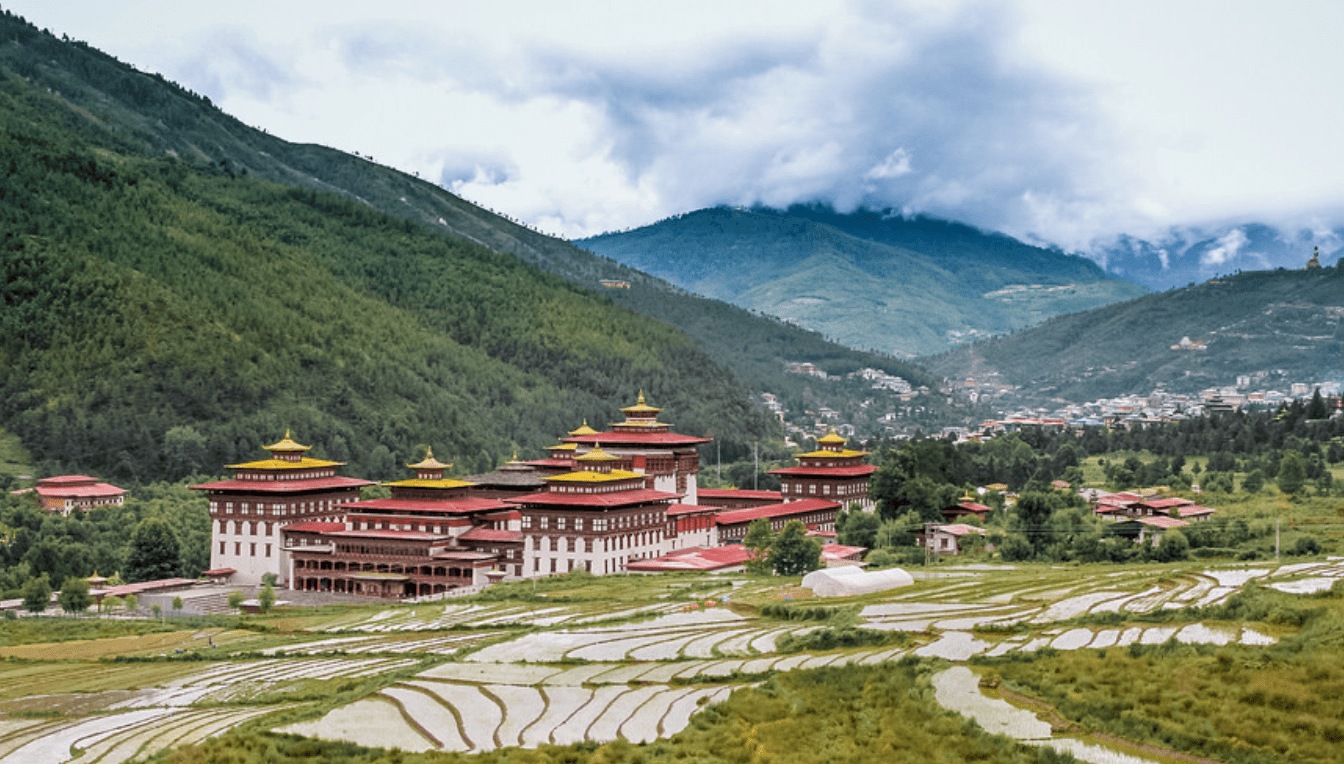
Samteling Palace (or Royal Cottage) in Thimphu, is the personal residence of the King of Bhutan.
Power of the Monarch
- As the head of the state, the Monarch is vested with the power to make appointments and award titles.
- The Monarch is also vested with judicial powers, such as granting amnesty and reduction of sentences.
- The Monarch is the supreme commander in chief of the armed force. Thus, the Monarch is vested with the power to declare war, and all peace treaties are made in his or her name.
- The Monarch has the prerogative to use relief fund instituted by the Parliament for urgent and unforeseen humanitarian relief.
- The Monarch is also vested with power to promote foreign relations.
- The Monarch summons the first sitting of Parliament after each general election.
- Any bill passed by the Parliament will come into force only upon the assent of the Monarch.
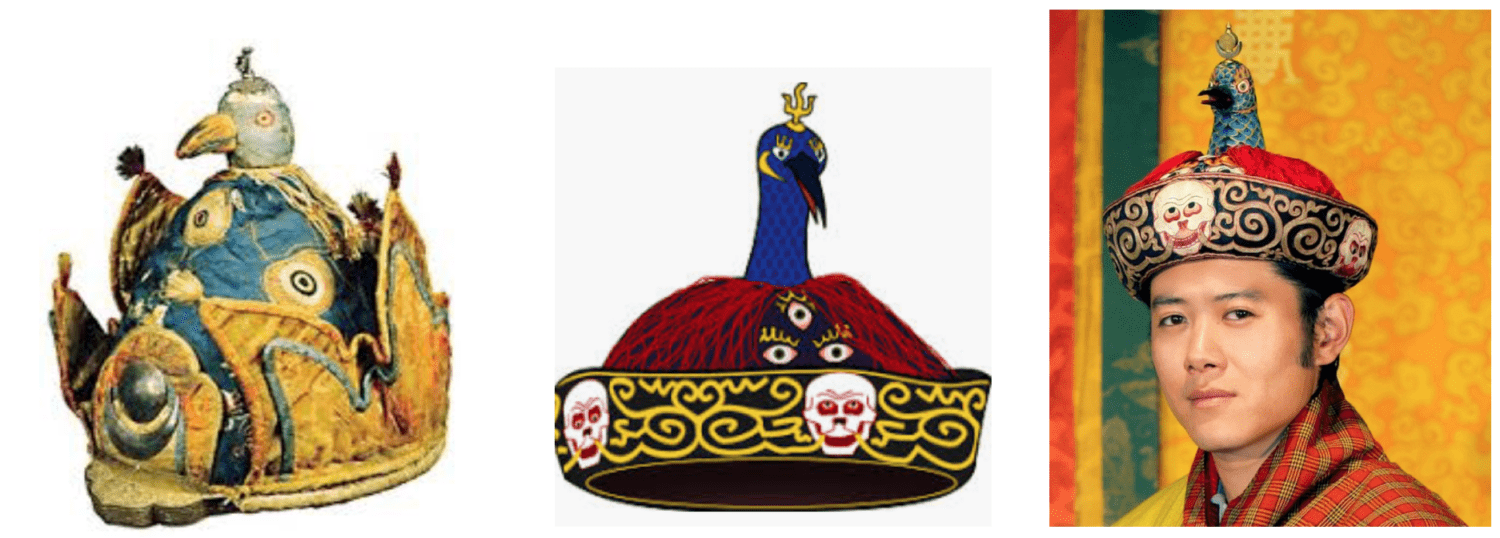
The original Raven crown of Jigme Namgyel (1825–1881), and the modern crowns.
The Raven Crown is worn by the Kings of Bhutan. It is a hat surmounted by the head of a raven. The raven is the world’s largest species of black birds, and the national bird of Bhutan. Its shining black feathers, distinctive voice, and playful nature represent power, mystery, wisdom, and intelligence. Known in Bhutan as Legon Jarog Donchen, the raven is seen as an emanation of Mahakala, the wrathful protective deity. As the nation’s protector, the raven is considered so sacred, that killing one bird is more heinous than the murder of a hundred monks.
The first king of the Wangchuck dynasty, Ugyen Wangchuck (1862–1926), was a charismatic figure who came to power during a turbulent period of bitter feuding and war. He adopted a crown with the head of a raven as the unique symbol of his authority. The first Raven Crown was worn as a battle helmet by his father, Jigme Namgyel (1825–1881). Known as the Black Regent, he wore it in bloody struggles against rivals including the British who tried unsuccessfully to subdue him.
Battle helmets, once called Tschap Jham, are constructed with hidden iron plates inside, then covered with silk and fleece. The helmet was believed to bring powers to the wearer. Jigme Namgyel considered the raven helmet his lucky protector, a key to his victory in keeping Bhutan a sovereign nation.
2) State Religion, Dratshang Lhentshog
The religious branch of the government is the Commission for the Monastic Affairs, or Dratshang Lhentshog of Bhutan. Its responsibility is to oversee the Drukpa Kagyu sect that is the state religion of Bhutan. The role of the religious bureaucracy is intended to complement secular institutions within a dual system of government.
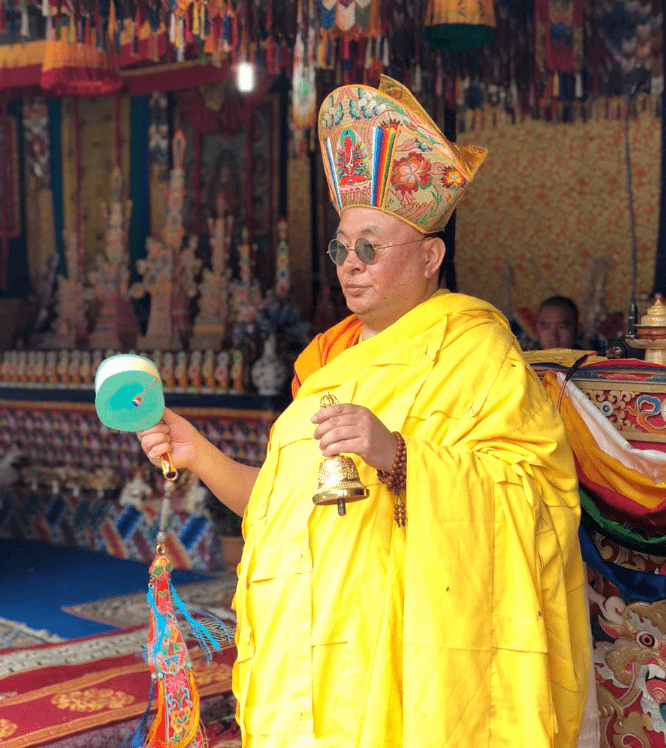
His Holiness, the Je Khenpo is the senior religious hierarch of Bhutan. His primary duty is to lead the Commission for Monastic Affairs, Dratshang Lhentshog, which oversees monasteries, and to arbitrate on matters of doctrine, assisted by Five Lopen Rinpoches.
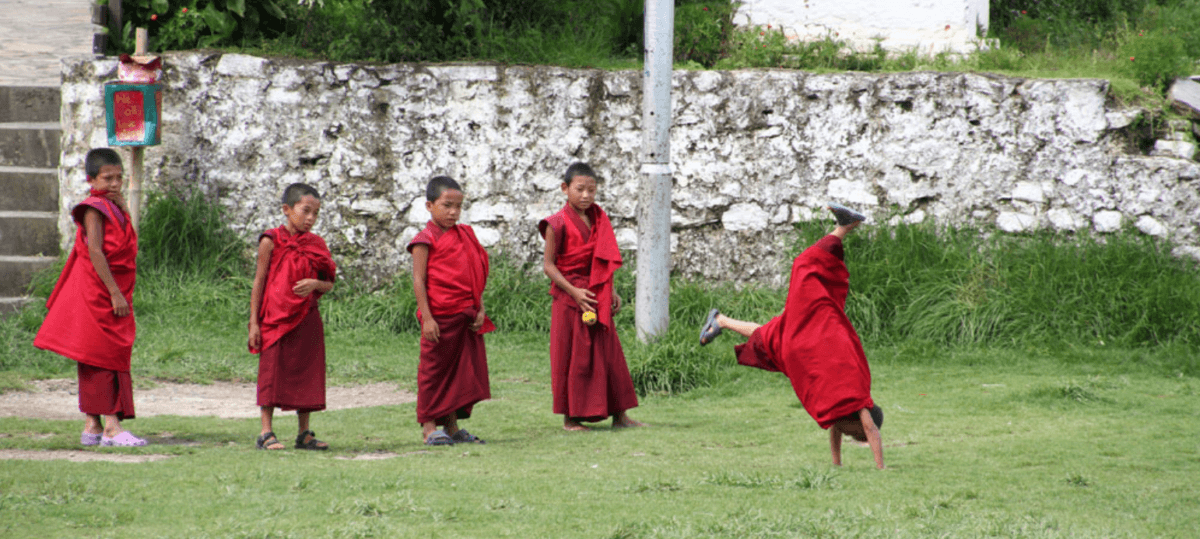
There are approximately 15,000 monks and nuns in Bhutan monasteries under the Commission for Monastic Affairs.
3) Judicial Branch
The Judicial branch of the government of Bhutan is based on legal codes established by Zhabdrung Ngawang Namgyal in 17th century and influenced by Anglo-Indian common law. Under the Constitution of 2008, the Judicial branch consists of the Supreme Court, the High Court, and twenty Dzongkhag Courts. The High Court is the first court of appeal, and the Supreme Court is the court of final appeal. The Supreme Court also has jurisdiction over constitutional questions and matters of national importance referred by the King.

Judges of the Supreme and High courts are appointed by the King.
4) Executive Branch, The Cabinet or Council of Ministers
Executive power is held by the Prime Minister and his cabinet of 10 ministers.The Cabinet, or Council of Ministers is the highest executive body in Bhutan. It was created in 1999 by Jigme Singye Wangchuck, the fourth King of Bhutan.
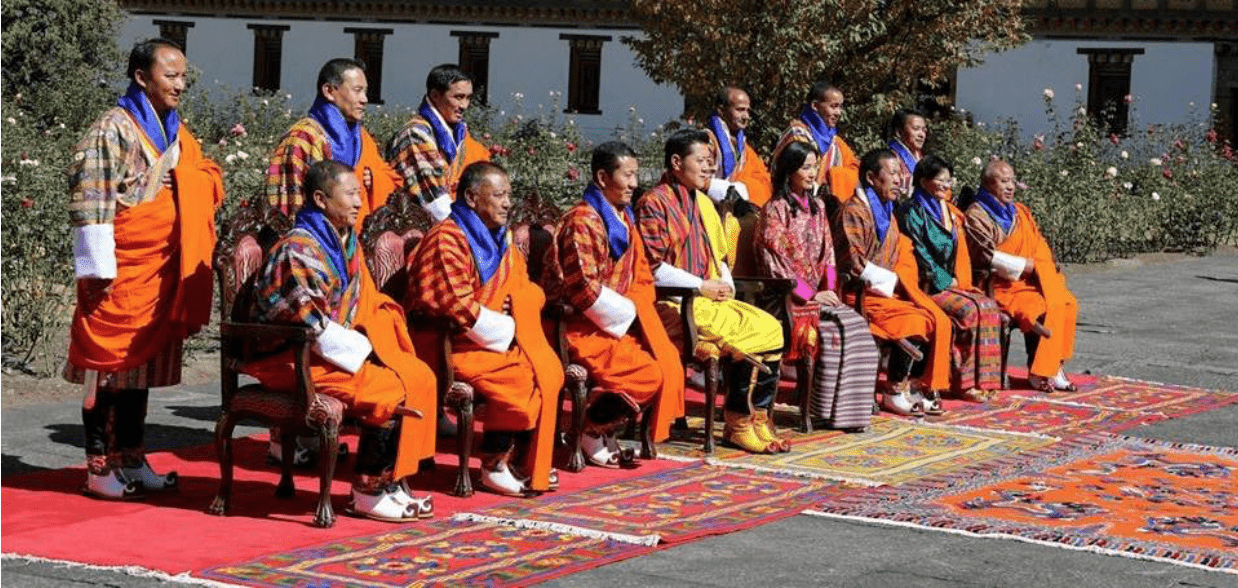
The Council of Ministers, or Cabinet, consists of the Prime Minister, and ten cabinet members nominated by the King, coming from the elected ruling party of the Assembly. They oversee government agencies, and fulfill many specific functions ranging from financial to domestic, industry, health, international relations, and education.
Colored Kabney Worn to Signify Government Branch
In Bhutan the Kabney is a formal silk scarf worn with a Gho, the national dress for men. The colors of the Khabney indicate the professional levels and areas of government. For example, a saffron Kabney is a symbol of royalty reserved for the King Druk Gyalpo and Je Khenpo, or chief monastic abbot. A blue Kabney stands for legislature, green is for judiciary, orange is for cabinet members, and white for common men of Bhutan. All Kabneys are 300 x 90 cm with fringe on both ends. See the different colors in the photos?
5) Legislative Branch
Legislative power is held by a parliament called Gyelyong Tshogde, that is bicameral. The parliament consists of a 25-member National Council (upper house) with no party affiliations, and a 47 member National Assembly (lower house) representing political parties.
National Council of Bhutan: The upper house was established in 2008 under Article 11 of the Constitution of Bhutan. It consists of 25 members, one directly elected from each of the 20 dzongkhags (districts) and five appointed by the King. An important function of the National Council is to ensure the transparency of political processes and decisions.
National Assembly of Bhutan: The lower house consists of 47 members directly elected by the citizens. The assembly elects a speaker and deputy speaker from among its members. The National Assembly was originally established in 1953 by the Third King Jigme Dorji Wangchuck. The functions of the National Assembly include making of laws, controlling finances of the State, and a critical role checking the actions of government and the ministries. The power to make laws is executed by vote on bills.
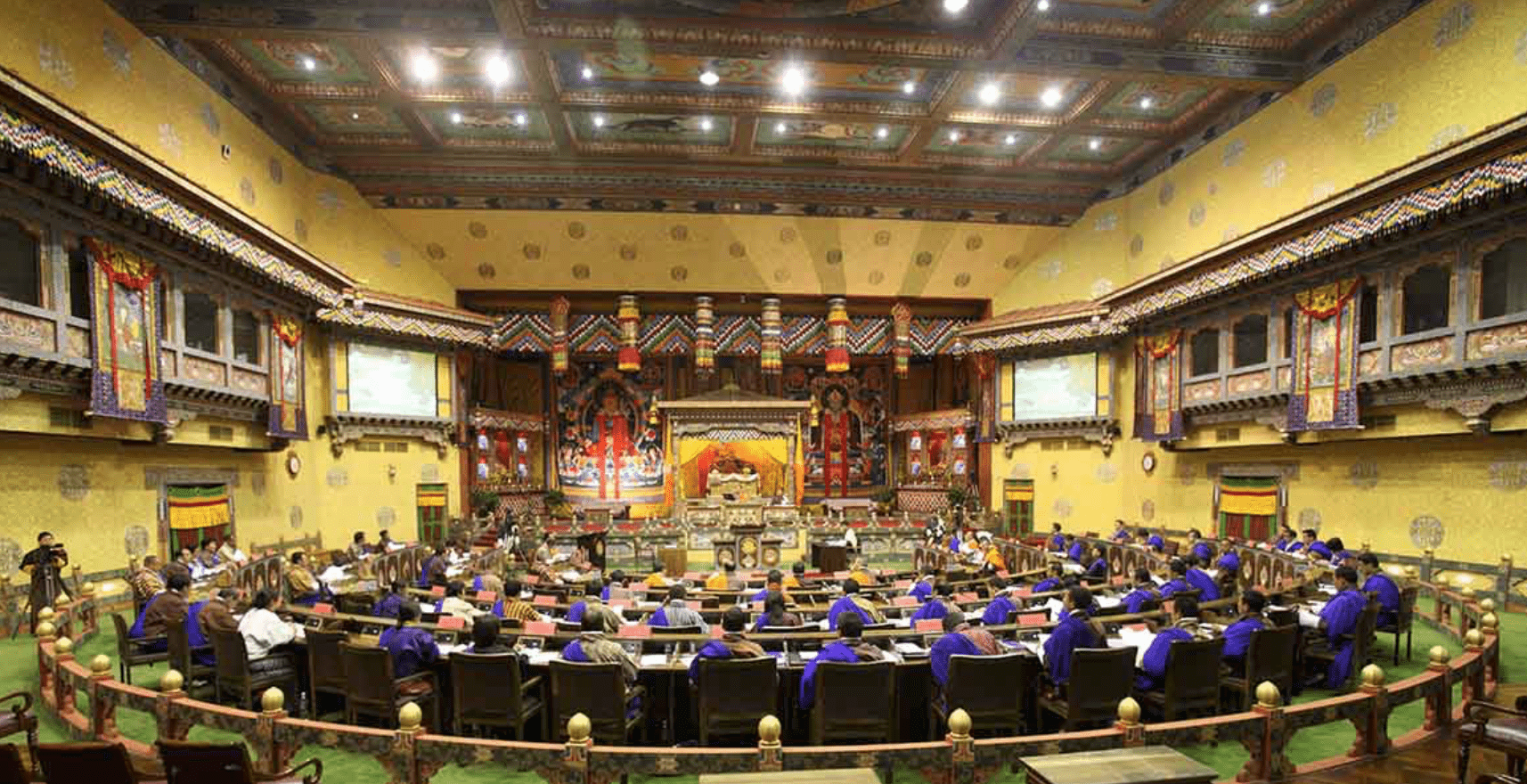
Bhutan may have the most beautiful Parliament building in the world. This is the General Assembly meeting hall in Thimphu. Do you notice the blue Kabneys worn by Parliament members?
Elections
Elections in Bhutan are conducted at national (parliamentary) and local levels. All citizens above 18 years are allowed to vote. Elections take place in primary and general rounds every five years.

History of Democracy in Bhutan
In Bhutan, the King is the head of the state and Prime Minister is the head of the government. Citizens exercise power by voting. Voting ensures people’s participation in the decision making of government. A democratic form of government allows for the voice of people to be heard, and ensure care for welfare of the nation as a whole.
In December 2006, the fourth King Jigme Singye announced he would abdicate the throne, making way for the young crown prince, King Jigme Khesar Namgyal Wangchuk. This move heralded a new era for Bhutan, the creation of a true democracy, under the guidance of its new and popular monarch.
The newly crowned fifth King made clear his desire to see changes in the country’s political system. Political parties, once regarded as a threat to peace and stability, came into being. Bhutan’s first general election was held in 2008, paving the way for the Bhutanese people to participate in the world’s most popular form of government. The new constitution of July 2008 formally changed Bhutan’s absolute monarchy into a constitutional monarchy.
Gross National Happiness – Guiding Philosophy of Bhutan’s Government
One unique feature of the Bhutan government is the guiding philosophy of Gross National Happiness, or GNH. The 4th King declared internationally that Gross National Happiness is more important than Gross National Product. In the Constitution of July 2008, Gross National Happiness was formally instituted as the goal of the government of Bhutan. Since then GNH is measured and analyzed annually. See my article on Gross National Happiness, Guiding Philosophy of Bhutan.
In conclusion, a Constitutional Monarchy ruled by a single leader, whose power is limited by a democratic constitution, ensures and protects the rights of the people. Hence, in Bhutan we believe it is one of the best forms of government to live in harmony.
